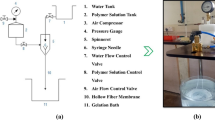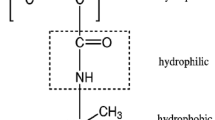Abstract
This work intends to model the equilibrium swelling behavior of highly branched polyamines. The developed model consists of three components: ionic, elastic and mixing. In this model, the ionic swelling pressure is explained using Donnan equilibrium swelling, Flory–Rehner phantom and affine network expression is taken into account for elastic components, and finally Gibbs energy of mixing is used for mixing contributions. Molar fraction of effective charges, named f parameter, is used in the gel swelling. The obtained results indicate that the volume swelling ratios of hydrogels in water are increased sharply by repeating mole fraction of poly(amidoamine). Comparing our theoretical results with the calculated results of Unal and Hedden, and also their experimental data, the validity of the proposed model is revealed. In comparison with the model proposed by Unal and Hedden, errors are decreased by 65.56%.









Similar content being viewed by others
References
Peppas NA, Bures P, Leobandung W, Ichikawa H (2000) Hydrogels in pharmaceutical formulations. Eur J Pharm Biopharm 50:27–46. https://doi.org/10.1016/S0939-6411(00)00090-4
Baldwin AD, Kiick KL (2010) Polysaccharide-modified synthetic polymeric biomaterials. Biopolymers 94:128–140. https://doi.org/10.1002/bip.21334
Chang C, Zhang L (2011) Cellulose-based hydrogels: present status and application prospects. Carbohydr Polym 84:40–53. https://doi.org/10.1016/j.carbpol.2010.12.023
Brannon-Peppast L (1991) Equilibrium swelling hydrogels of pH-sensitive. Chem Eng 46:715–722. https://doi.org/10.1016/0009-2509(91)80177-Z
Zhang Y, An D, Pardo Y et al (2017) High-water-content and resilient PEG-containing hydrogels with low fibrotic response. Acta Biomater 53:100–108. https://doi.org/10.1016/j.actbio.2017.02.028
Yom-tov O, Seliktar D, Bianco-peled H (2016) PEG-Thiol based hydrogels with controllable properties. Eur Polym J 74:1–12. https://doi.org/10.1016/j.eurpolymj.2015.11.002
Khoee S, Kardani M (2014) Preparation of PCL/PEG superporous hydrogel containing drug-loaded nanoparticles: the effect of hydrophobic-hydrophilic interface on the physical properties. Eur Polym J 58:180–190. https://doi.org/10.1016/j.eurpolymj.2014.06.024
Mintzer MA, Grinstaff MW (2011) Biomedical applications of dendrimers: a tutorial. Chem Soc Rev 40:173–190. https://doi.org/10.1039/B901839P
Jain K, Kesharwani P, Gupta U, Jain NK (2010) Dendrimer toxicity: let’s meet the challenge. Int J Pharm 394:122–142. https://doi.org/10.1016/j.ijpharm.2010.04.027
Shcharbin D, Pedziwiatr E, Blasiak J, Bryszewska M (2010) How to study dendriplexes II: transfection and cytotoxicity. J Control Release 141:110–127. https://doi.org/10.1016/j.jconrel.2009.09.030
Shcharbin D, Janaszewska A, Klajnert-Maculewicz B et al (2014) How to study dendrimers and dendriplexes III. Biodistribution, pharmacokinetics and toxicity in vivo. J Control Release 181:40–52. https://doi.org/10.1016/j.jconrel.2014.02.021
Bahadir EB, Sezgintürk MK (2016) Poly(amidoamine) (PAMAM): an emerging material for electrochemical bio(sensing) applications. Talanta 148:427–438. https://doi.org/10.1016/j.talanta.2015.11.022
Cheng Y, Zhao L, Li Y, Xu T (2011) Design of biocompatible dendrimers for cancer diagnosis and therapy: current status and future perspectives. Chem Soc Rev 40:2673. https://doi.org/10.1039/c0cs00097c
Prato M, Gruttadauria M (2016) Single-walled carbon nanotube–polyamidoamine dendrimer hybrids for heterogeneous. Catalysis. https://doi.org/10.1021/acsnano.6b00936
Kesharwani P, Jain K, Jain NK (2014) Dendrimer as nanocarrier for drug delivery. Prog Polym Sci 39:268–307. https://doi.org/10.1016/j.progpolymsci.2013.07.005
Menjoge AR, Kannan RM, Tomalia DA (2010) Dendrimer-based drug and imaging conjugates: design considerations for nanomedical applications. Drug Discov Today 15:171–185. https://doi.org/10.1016/j.drudis.2010.01.009
Sen M, Guven O (1998) Prediction of swelling behaviour of hydrogels containing diprotic acid moieties. Polymer 39:1165–1172. https://doi.org/10.1016/S0032-3861(97)00391-1
Agnihotri SA, Mallikarjuna NN, Aminabhavi TM (2004) Recent advances on chitosan-based micro- and nanoparticles in drug delivery. J Control Release 100:5–28. https://doi.org/10.1016/j.jconrel.2004.08.010
Okay O, Sariişik SB, Zor SD (1998) Swelling behavior of anionic acrylamide-based hydrogels in aqueous salt solutions: comparison of experiment with theory. J Appl Polym Sci 70:567–575. https://doi.org/10.1002/(SICI)1097-4628(19981017)70:3<567:AID-APP19>3.0.CO;2-Y
Flory PJ (1953) Principles of polymer chemistry title, illustrate. Cornell University Press, New York
Tanaka T, Fillmore DJ (1979) Kinetics of swelling of gels. J Chem Phys 70:1214–1218. https://doi.org/10.1063/1.437602
Katchalsky A, Lifson S, Eisenberg H (1951) Equation of Swelling for Polyelectrolyte Gels. J Polym Sci 7:571–574. https://doi.org/10.1002/pol.1951.120070513
Ishidao T, Akagi M, Sugimoto H et al (1995) Swelling equilibria of poly(N-isopropylacrylamide) gel in aqueous polymer solutions. Fluid Phase Equilib 104:119–129. https://doi.org/10.1016/0378-3812(94)02643-F
Rička J, Tanaka T (1984) Swelling of ionic gels: quantitative performance of the donnan theory. Macromolecules 17:2916–2921. https://doi.org/10.1021/ma00142a081
Dušek K, Patterson D (1968) Transition in swollen polymer networks induced by intramolecular condensation. J Polym Sci Part Polym Phys 6:1209–1216. https://doi.org/10.1002/pol.1968.160060701
Amiya T, Tanaka T (1987) Phase transitions in cross-linked gels of natural polymers. Macromolecules 20:1162–1164. https://doi.org/10.1021/ma00171a050
Lee CH, Yi YD, Park HR, Bae YC (2016) Applicability of lattice-based thermodynamic models to various types of hydrogel swelling behaviors. Fluid Phase Equilib 427:594–604. https://doi.org/10.1016/j.fluid.2016.08.017
Adamova LV, Safronov AP, Terziyan TV et al (2018) Thermodynamics of swelling of polyacrylamide and poly (methacrylic acid) lyophilized xerogels. Water 60:190–197. https://doi.org/10.1134/S0965545X18020013
Unal B, Hedden RC (2009) pH-dependent swelling of hydrogels containing highly branched polyamine macromonomers. Polymer (Guildf) 50:905–912. https://doi.org/10.1016/j.polymer.2008.11.049
Flory PJ, Rehner J (1943) Statistical mechanics of cross-linked polymer networks II. Swelling. J Chem Phys 11:521–526. https://doi.org/10.1063/1.1723792
Hild G (1997) Interpretation of equilibrium swelling data on model networks using affine and ‘phantom’ network models. Polymer 38:3279–3293. https://doi.org/10.1016/S0032-3861(96)00878-6
Unal B, Hedden RC (2006) Gelation and swelling behavior of end-linked hydrogels prepared from linear poly(ethylene glycol) and poly(amidoamine) dendrimers. Polymer (Guildf) 47:8173–8182. https://doi.org/10.1016/j.polymer.2006.09.048
Author information
Authors and Affiliations
Corresponding author
Rights and permissions
About this article
Cite this article
Vahidzadeh, R., Khorram, M. & Shariati, A. Model modification for equilibrium swelling of highly branched polyamine macromonomers. Polym. Bull. 76, 1115–1133 (2019). https://doi.org/10.1007/s00289-018-2438-3
Received:
Revised:
Accepted:
Published:
Issue Date:
DOI: https://doi.org/10.1007/s00289-018-2438-3




